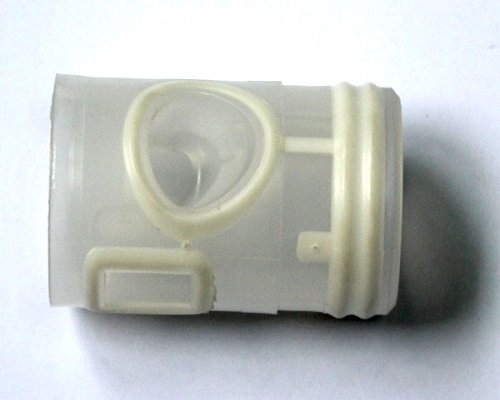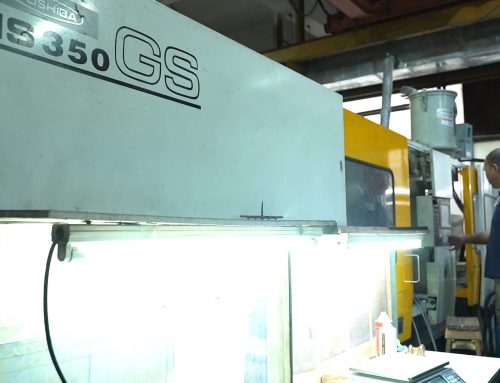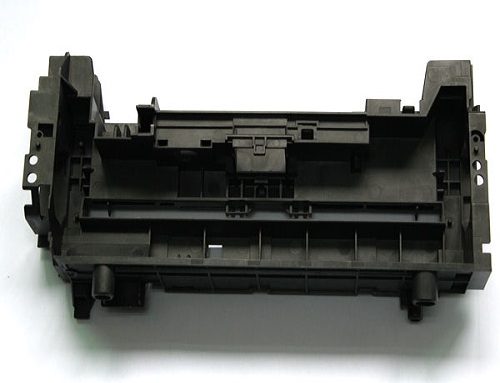TPU injection molding note
TPU (thermoplastic polyurethane) plastic injection molding process has many methods, including injection molding, blow molding, compression molding, extrusion molding, etc., among which the most commonly used is injection molding. The INJECTION molding process is used to make TPU injection molding parts, which are divided into three stages: pre-plasticization, injection and ejection. Injection machine is divided into plunger type and screw type. A screw injector is recommended because it provides a uniform rate of plasticization and melting.
TPU mobile phone case molding
1. Injection molding machine design
The barrel of the injection molding machine is lined with copper and aluminum alloy, and the screws are chrome plated to prevent wear. The length-diameter ratio of screw L/D = 16 ~ 20 is good, at least 15; The compression ratio is 2.5/1 ~ 3.0/1. The length of the feeding section is 0.5L, the length of the compression section is 0.3L, and the length of the metering section is 0.2L. The check ring shall be installed near the top of the screw to prevent backflow and maintain maximum pressure.
The TPU shall be treated with a self-flowing nozzle with an inverted cone at the exit. The diameter of the nozzle shall be larger than 4mm and smaller than 0.68mm at the entrance of the main channel sleeve ring. The nozzle shall be equipped with controllable heating belt to prevent material solidification.
From the economic point of view, the injection quantity should be 40% – 80% of the quantity. Screw rotation speed is 20-50 R/min.
2. Mold design
Molddesign should pay attention to the following points:
(1) Shrinkage of molded TPU parts
Shrinkage is affected by hardness, thickness, shape, forming temperature, die temperature and other forming conditions. Typically, the shrinkage range is 0.005-0.020cm/cm. For example, a 100×10×2mm rectangular specimen shrinks in the direction of sprue length and flow, and the hardness of 75A is 2-3 times that of 60D. The hardness and thickness of TPU will affect the shrinkage rate. When the hardness of TPU is between 78A and 90A, the shrinkage decreases with the increase of thickness. When the hardness is between 95A and 74D, the shrinkage rate increases slightly with the increase of thickness.
(2) Good flow passage and cold groove
The main flow passage is the part of the flow passage that connects the injector nozzle to the flow passage or cavity in the mold. The diameter should be enlarged inward at an Angle greater than 2O to facilitate removal of channel vegetation. The shunt channel is a channel connecting the main channel and each cavity in the multi-groove mold. The layout of the channel on the mold shall be symmetrical and equidistant. Flow channels can be round, semicircular or rectangular, with a diameter of 6-9mm. Runner surfaces must be polished like cavities to reduce flow resistance and provide faster filling.
A cold well is an empty space at the end of the main stream (extension runner) that is used to capture the cold material generated between the two injection slots at the end of the nozzle to prevent the shunt runner or gate from entering and being blocked by the cold material. When the cold material is mixed into the mold cavity, the internal stress of the product is easy to occur. The cold bore is 8-10 mm in diameter and approximately 6 mm in length.
(3) Gate and vent
The gate is the runner connecting the main or shunt runner to the cavity. Its cross-sectional area is usually smaller than the runner passage, which is the smallest part of the runner system, and its length should be short. The gate is rectangular or round in shape, and the size increases with the thickness of the product. The thickness of the product is less than 4mm and the diameter is 1mm; The sprue shall be 4-8mm thick and 1.4mm in diameter. The gate thickness is greater than 8mm and the diameter is 2.0-2.7mm. The gate position is usually selected on the thickest part of the product, which is not affected by appearance and use and is at right angles to the mold to prevent shrinkage and avoid spiralling.
A vent or vent is a grooved air outlet that opens in the mold to prevent molten material from entering the mold into the gas and draining the gas from the mold cavity. Otherwise, the product may have pores, poor fusion, insufficient filling or gas trap, or even burn out due to high temperature caused by air compression, resulting in internal stress of the product. The outlet can be set at the end of the melt flow in the mold cavity or at the parting line of the plastic mold with a depth of 0.15mm and a width of 6mm.
It is necessary to control the die temperature as uniformly as possible to avoid warping and twisting of parts.
3 Forming conditions
The most important forming conditions for TPU (thermoplastic polyurethane) are the temperature, pressure and time of plasticizing flow and cooling. These parameters affect the appearance and performance of TPU components. Good processing conditions should be able to obtain white to beige parts.
(1) Temperature
The temperature to be controlled during TPU molding includes barrel temperature, nozzle temperature and mold temperature. The first two temperatures mainly affect the plasticizing and flow of TPU, while the second temperature affects the flow and cooling of TPU molded parts.
(2) Cylinder temperature
The selection of cylinder temperature is related to the hardness of TPU material. The high hardness TPU has a high melting temperature and the maximum temperature at the end of the barrel is also very high. The temperature range of TPU processing barrel is 177 ~ 232℃. Generally, the temperature distribution of the barrel increases gradually from one side of the hopper (the back end) to the nozzle (the front end) to make the TPU temperature rise steadily and achieve the purpose of uniform plasticization.
(3) Nozzle temperature
The nozzle temperature is usually slightly below the maximum barrel temperature to prevent the molten material from salivating in the straight nozzle. If a self-locking nozzle is used to prevent salivation, the nozzle temperature can also be controlled within the maximum temperature range of the barrel.
(4) Mold temperature
Mold temperature has a great influence on the internal performance and appearance quality of TPU products. It depends on the crystallinity and product size of TPU. The mold temperature is usually controlled by a constant temperature cooling medium, such as water. TPU has high hardness, high crystallinity and high mold temperature. For example, texin, hardness 480A, mold temperature 20-30℃; Hardness 591A, mold temperature 30-50℃; Hardness 355d, mold temperature 40-65℃. The mold temperature of TPU products is generally 10-60℃. The mold temperature is low, the melted material freezes prematurely and produces streamline, which is not conducive to the growth of spherulites. Therefore, the low crystallinity of the product will lead to the late crystallization period, resulting in the late shrinkage and performance change of the product.
(5)Pressure
The injection process is the pressure including the plasticizing pressure (back pressure) and the injection pressure. As the screw recede, the pressure at the top of the melt is the back pressure, which is regulated by the relief valve. Increasing the back pressure will increase the melt temperature, reduce the plasticizing speed, make the melt temperature uniform, and uniform color, and exhaust the melt gas, but will prolong the forming cycle.
TPU usually has a back pressure of 0.3 ~ 4MPa. Injection pressure is the pressure applied on the TPU by the top of the screw. Its function is to overcome the flow resistance of TPU from the cylinder to the cavity, fill the mold with molten material, and compacting the molten material. The flow resistance and filling rate of TPU are closely related to melt viscosity, which is directly related to TPU hardness and melt temperature. In other words, melt viscosity not only depends on temperature and pressure, but also depends on TPU hardness and deformation rate. The higher the shear rate is, the lower the viscosity is. The higher the hardness of TPU, the higher the viscosity. Relationship between viscosity and shear rate of resins with different hardness (240℃). At the same shear rate, the viscosity decreases with the increase of temperature, but at the high shear rate, the viscosity is not affected by temperature as much as at the low shear rate.
TPU injection pressure is generally 20 ~ 110MPa. The holding pressure is about half of the injection pressure, and the back pressure should be 1. Below 4MPa for uniform plasticization of TPU. Melt viscosity depends not only on temperature and pressure, but also on the hardness and deformation rate of TPU. The higher the shear rate is, the lower the viscosity is. The higher the hardness of TPU, the higher the viscosity. Relationship between viscosity and shear rate of resins with different hardness (240℃). At the same shear rate, the viscosity decreases with the increase of temperature, but at the high shear rate, the viscosity is not affected by temperature as much as at the low shear rate. TPU injection pressure is generally 20 ~ 110MPa.
保压约为注射压力的一半,背压应为1。为了使TPU均匀塑化,应低于4MPa。
(6)循环时间
The cycle time required to complete the injection process is called the molding cycle time. Cycle time includes filling time, holding time, cooling time, and other times (open, demoulder, close, etc.), which directly affect labor productivity and equipment utilization. TPU molding cycle is usually determined by hardness, thickness and configuration. TPU has short high hardness cycle, long thick cycle of plastic parts, long complex cycle of plastic parts configuration, and the molding cycle is also related to mold temperature. TPU molding cycle is usually between 20 and 60 seconds.
(7)Infusion speed
Infusion speed depends on the configuration of the TPU product. Thicker end faces require a lower injection rate, while thinner end faces require a faster injection rate.
(8)Screw speed
The processing of TPU molded products usually requires a lower shear rate, so a lower screw speed is appropriate. The screw speed of TPU is generally 20-80r/min, so 20-40r/min is preferred.
4 Shutdown processing
Since TPU (thermoplastic polyurethane) degrades for a long time at high temperature, PS, PE, acrylic plastic or ABS should be used for cleaning after shutdown. If the shutdown lasts more than an hour, turn off the heat.
5 Product post-processing
由于圆筒中TPU的塑化不均匀或模腔中冷却速度的不同,经常会产生不均匀的结晶,取向和收缩,导致产品的内部应力的存在,特别是在厚壁产品或产品中与金属插件。具有内应力的产品的机械性能通常会降低,并且产品表面会出现裂纹,甚至变形和断裂。
The solution to these problems in production is to anneal the product. Annealing temperature depends on hardness of TPU product. Products with high hardness have higher annealing temperature and lower hardness temperature. Too high temperature may cause the product to warp or deform, while too low temperature will not eliminate the internal stress. TPU should be annealed at low temperature for a long time, and products with low hardness can be left at room temperature for several weeks for optimal performance. Hardness can be annealed at 80 ° c ×20h at shaw A85 and at 100 ° c ×20h on A85. Annealing may be carried out in a hot air furnace, taking care not to localize overheating and deformation of the product.
Annealing can not only eliminate internal stress, but also improve mechanical properties. Because TPU is a two-phase form, phase mixing occurs during TPU hot processing. When a TPU molded product cools rapidly due to its high viscosity and slow phase separation, it must have sufficient time to separate and form tiny regions for optimal performance.
6 Injection molding
To meet assembly and service strength requirements, TPU molded parts need to be embedded with metal plug-ins.
Metal inserts are first placed in a predetermined position in the mold and then injected throughout the product. Due to the great difference in thermal performance and shrinkage between metal inserts and TPU, TPU products with inserts cannot be firmly bonded together. Solution is to preheat the metal insert, because after preheating will lower melt temperature, thus make the melt around the insert can slow cooling, and shrinkage in injection process is relatively uniform, and has a certain effect of hot material feed might happen this kind of situation, in order to prevent excessive internal stress around the blade.
TPU is easy to Mosaic and the Mosaic shape is not limited. After degreasing the inlay only, heat 1 at 200-230℃. The peel strength can reach 6-9kg / 25mm within 5-2 minutes. To obtain a stronger bond, an adhesive can be applied to the insert, which is then heated at 120℃ and injected.In addition, it should be noted that the TPU used should not contain lubricants.
7 Recycling of recycled materials
During TPU processing, waste such as main channel, shunt channel and unqualified products can be recycled. According to the experimental results, 100% recycled materials can be fully utilized without adding new materials, and the mechanical properties will not be seriously reduced. However, in order to keep the physical and mechanical properties and injection conditions at the optimal level, the proportion of recycled materials is recommended to be 25% ~ 30%.
It should be noted that the types and specifications of recycled and new materials should be the same. Contaminated or annealed recycled materials shall not be used. Recycled materials should not be stored for too long. It is better to granulate and dry immediately.





